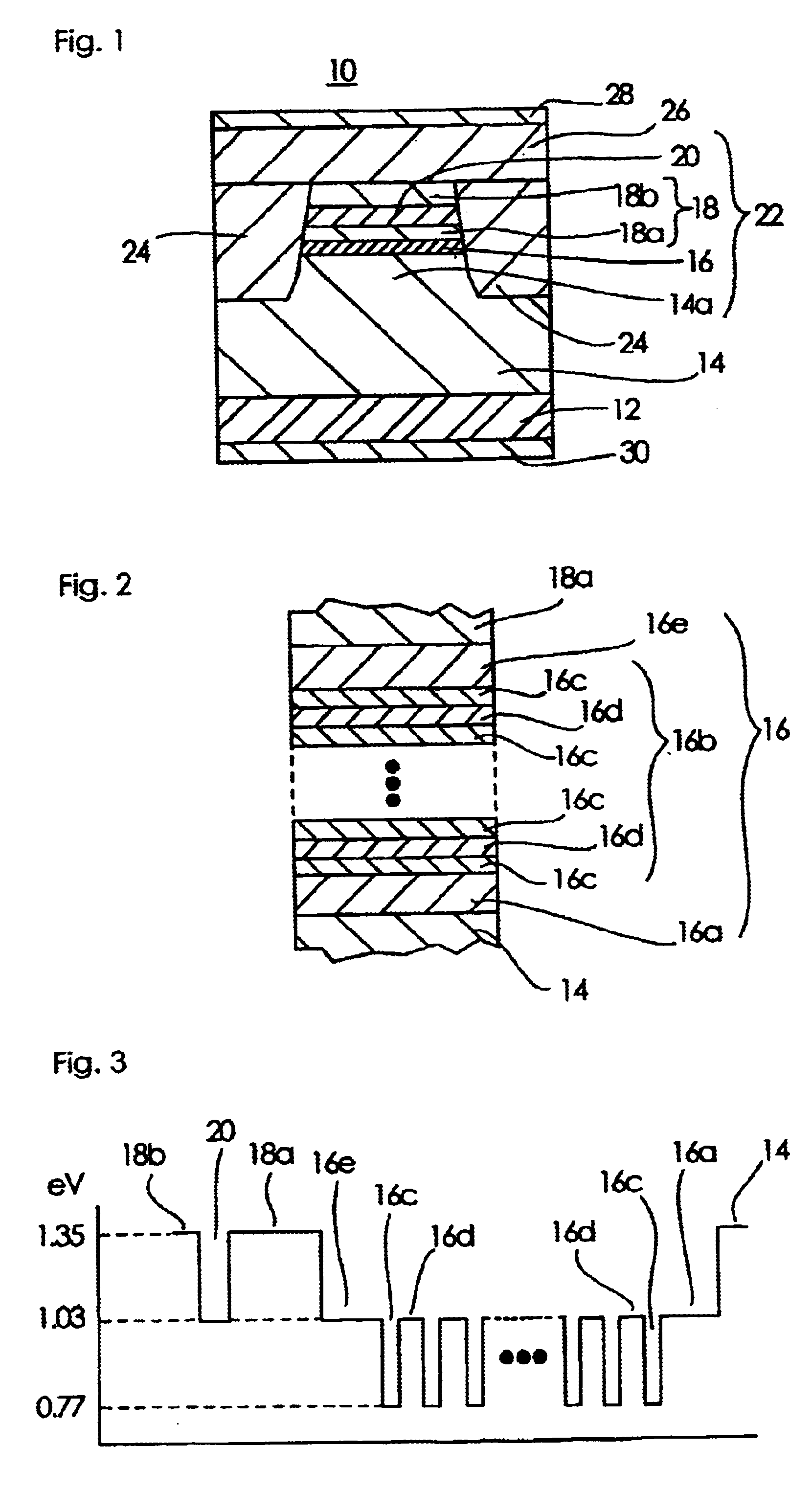Semiconductor laser device
a laser device and semiconductor technology, applied in semiconductor lasers, lasers, laser details, etc., can solve problems such as the reduction of optical output due to the effect of slope efficiency and small reduction of optical outpu
- Summary
- Abstract
- Description
- Claims
- Application Information
AI Technical Summary
Benefits of technology
Problems solved by technology
Method used
Image
Examples
first embodiment
[0041]FIG. 1 is a cross-sectional view of a semiconductor laser according to a first embodiment of the present invention.
[0042]In the figure, reference numeral 10 denotes a semiconductor laser. In FIG. 1, the optical waveguide direction of the semiconductor laser 10 is perpendicular to the paper. Reference numeral 12 denotes a p-InP substrate used as the semiconductor substrate, and 14 denotes a p-InP cladding layer which is a first cladding layer disposed on the p-InP substrate 12. The p-InP cladding layer 14 has a bandgap energy of 1.35 eV, a layer thickness of 1,000 nm, and a carrier concentration of 1×1018 cm−1. Reference numeral 16 denotes an active region disposed on the p-InP cladding layer 14.
[0043]Reference numeral 18 denotes an n-InP cladding layer which is a second cladding layer disposed on the active region 16. According to the present embodiment, the n-InP cladding layer 18 comprises two layers: an n-InP cladding layer 18a adjacent the active region 16; and an n-InP cl...
second embodiment
[0090]FIG. 8 is a cross-sectional view of a semiconductor laser according to a second embodiment of the present invention.
[0091]In the figure, reference numeral 40 denotes a semiconductor laser. In FIG. 8, the optical waveguide direction of the semiconductor laser 40 is perpendicular to the paper. Reference numeral 42 denotes a p-AlGaInAs cladding layer used as the semiconductor layer.
[0092]Employing a p-InP substrate 12, the semiconductor laser 40 is configured much in the same way as the semiconductor laser 10 of the first embodiment. However, whereas the semiconductor laser 10 is configured such that the n-InGaAsP cladding layer 20 having a refractive index higher than that of the n-InP cladding layer 18 is inserted into the n-InP cladding layer 18, the semiconductor laser 40 is configured such that a p-AlGaInAs cladding layer having a refractive index lower than that of the p-InP cladding layer 14 is inserted into the p-InP cladding layer 14.
[0093]In the semiconductor laser 40, ...
third embodiment
[0112]FIG. 11 is a cross-sectional view of a semiconductor laser according to a third embodiment of the present invention.
[0113]In the figure, reference numeral 50 denotes a semiconductor laser. In FIG. 11, the optical waveguide direction of the semiconductor laser 50 is perpendicular to the paper.
[0114]Reference numeral 52 denotes an n-InP substrate used as the semiconductor substrate. The n-InP substrate 52 has disposed thereon the n-InP cladding layer 18b which in turn has the n-InGaAsP cladding layer 20 disposed thereon. Furthermore, the n-InP cladding layer 18a is disposed on the n-InGaAsP cladding layer 20. The n-InP cladding layers 18a and 18b collectively constitute the n-InP cladding layer 18, which is a first cladding layer.
[0115]In addition, the active region 16 is disposed on the n-InP cladding layer 18a, and the p-InP cladding layer 14, which is a second cladding layer, is disposed on the active layer 16.
[0116]The p-InP cladding layer 14, the active region 16, the n-InP...
PUM
 Login to View More
Login to View More Abstract
Description
Claims
Application Information
 Login to View More
Login to View More - R&D
- Intellectual Property
- Life Sciences
- Materials
- Tech Scout
- Unparalleled Data Quality
- Higher Quality Content
- 60% Fewer Hallucinations
Browse by: Latest US Patents, China's latest patents, Technical Efficacy Thesaurus, Application Domain, Technology Topic, Popular Technical Reports.
© 2025 PatSnap. All rights reserved.Legal|Privacy policy|Modern Slavery Act Transparency Statement|Sitemap|About US| Contact US: help@patsnap.com



